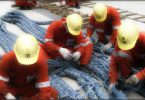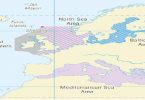- Cargoes can be tested using either the flow table method or the penetration test method, both of which involve increasing the moisture content of a sample until actual liquefaction is observed.
- For genuine Group C cargoes, this point is never reached and so no transportable moisture limit can be determined. As a result, any cargo that possesses a TML determined by either of these methods is a Group A cargo. However, it should be noted that some materials that are untestable by these tests may still liquefy, and as such are Group A cargoes. Similarly, any cargoes for which actual liquefaction occurs (for example by a flattening of the stow or large-scale cargo flow during ocean carriage) are Group A cargoes, independently of any tests carried out.
- On a practical level, Group A cargoes contain sufficient small particles that they can take on a muddy consistency if wet enough. Group C cargoes, by contrast, are gravel-like materials that never become muddy regardless of how wet they are, as any water added drains through the gaps between the particles. Simple qualitative tests to assess this can be carried out on the spot by taking a cargo sample and adding water to it to see if it turns into a mud-like consistency. If yes, the material is likely to be a Group A cargo.
Table of Contents of IMSBC code.
Foreword
Section 1 General provisions and definitions
Section 2 General loading, carriage and unloading precautions
Section 3 Safety of personnel and ship
Section 4 Assessment of acceptability of consignments for safe shipment
Section 5 Trimming procedures
Section 6 Methods of determining angle of repose
Section 7 Cargoes that may liquefy
Section 8 Test procedures for cargoes that may liquefy
Section 9 Materials possessing chemical hazards
Section 10 Carriage of solid bulk wastes
Section 11 Security provisions
Section 12 Stowage factor conversion tables
Section 13 References
Appendix 1 Individual schedules of solid bulk cargoes
Appendix 2 Laboratory test procedures, associated apparatus and standards
Appendix 3 Properties of solid bulk cargoes
Appendix 4 Index of solid bulk cargoes



